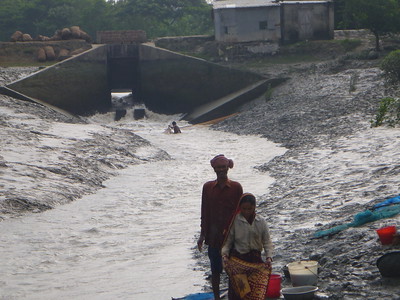With a population of roughly 150 million people, the delta country of Bangladesh holds about half the population of the entire United States in an area the size of Louisiana, and exists under a near-constant risk of sea level rise and other dynamic climate changes.
Now, as the world faces a future chock-full of increasing environmental transformation, an international, transdisciplinary team of academic researchers—including multiple faculty members across Vanderbilt—is looking to Bangladesh for clues about adaptability and resilience.
To showcase the scope of the project and highlight the work and results thus far, the team produced a short film that recently played at the 2019 American Geophysical Union annual meeting. The 10-minute film showcased researchers across Vanderbilt and collaborating institutions. Among them is Hiba Baroud, assistant professor of civil and environmental engineering, who is investigating how environmental changes affect transportation of goods and materials through the Ganges-Brahmaputra delta.
“The changes have reconfigured the inland waterways, with some of them no longer navigable and others where marine traffic has increased,” Hiba Baroud said. “We are trying to determine how vulnerable these nodes are, and if we can understand the social and economic impacts along with the environmental ones we can project more into the future.”
The focus on Bangladesh and need for collaborative research into this important section of the world has widespread application.
“What Bangladesh has to offer the rest of the world is a society that has developed and adapted to rapid environmental change and dynamics,” said Steven Goodbred Jr., professor and chair of earth and environmental sciences and principal investigator on the project.
“Every year, 30 to 50 percent of the country is underwater for several weeks to months during the summer monsoon season,” Goodbred said. “Humans living in Bangladesh endure and progress despite substantial risks – from sea level rise to faulty infrastructure.”

Thanks to a Science, Engineering and Education for Sustainability (SEES) grant from the National Science Foundation, the international team has been able to continue their collaborative research on the Ganges-Brahmaputra delta in Bangladesh that began in 2010 to learn more about how the natural landscape evolves and adapts to climate change. Over this time, the research group has grown with faculty across Vanderbilt joining the project.
Along with Goodbred, Vanderbilt faculty in Earth and Environmental Sciences John Ayers and Jonathan Gilligan, both of whom have secondary appointments in the School of Engineering, continue to examine how environmental changes impact everything from the crop economy to soil erosion. Other engineering faculty with the Vanderbilt Institute Energy and Environment and Vanderbilt Engineering Center for Transportation and Operational Resiliency are involved as well.
Areas of research have included previous work on changing livelihoods and labor statistics, migration opportunities and water security.
“Our current project brings together multiple areas of expertise on a number of issues, to yield a more integrated understanding of how rapid environmental changes are affecting Bangladesh,” added Goodbred. “Our mission is to walk away with lessons for how the rest of the world might find ways for adapting to variable environmental change, but critically to also lay the foundation for scientific research into many other social and cultural issues in the area.”
To learn more about the current work in Bangladesh, visit the VU project website.